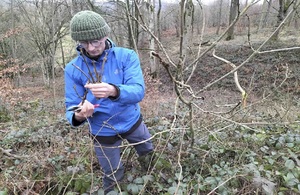Derbyshire ash trees playing vital role in protecting species
Samples collected by Natural England will protect trees species from ash dieback

Natural England staff members working with Ash trees
Ash tree samples from Derbyshire woodlands are being collected by Natural England as part of a national project to protect the tree species from being devastated by disease.
Natural England is playing a key role in helping secure the future of the ash tree by supporting the Living Ash Project. Including Future Trees Trust, the project is collecting samples of ash that show resistance to ash dieback.
Ash dieback is a fungus which originated in Asia and its introduction about 30 years ago has devastated the European ash. The disease is predicted to kill up to 80% of ash trees across the UK, changing the landscape forever and threatening many species which rely on ash.
Future Trees Trust is collecting samples from across the country to grow in its national archives including ash trees which show high tolerance to ash dieback. The samples will be used for breeding work, field trials and genetic research.
So far more than 1000 tolerant ash trees have been sampled and planted within a public forest estate in Hampshire to start the first national archive.
The Trust is now gathering more samples from ash trees, showing a strong tolerance to ash dieback in the Derbyshire Dales and asked woodland site managers to keep track of any ash trees on their sites, where samples could be collected. This included sites in the Peak District Dales, owned by the National Trust and Chatsworth Estate.
The sample collection in Derbyshire was supported by Natural England’s LIFE in the Ravines partnership, which is using EU LIFE funding to restore ravine woodlands in the Peak District Dales Special Area of Conservation (SAC), which is dominated by infected ash trees.
So far, the project has planted over 51,000 trees across the Peak District Dales SAC, restoring ravine woodlands in areas including the iconic five dales of the Derbyshire Dales National Nature Reserve, such as the well-visited Lathkill.
Neil Ford, Wooded Habitats Specialist at Natural England, said:
Ash Dieback is having a devastating impact across the country and on the ash dominated ancient woodlands of the Peak District Dales. The LIFE in the Ravines Project Partnership has been working hard to secure the future of these sensitive habitats through a systematic approach to replacing the thinning ash canopy with native trees species that once thrived in these special places.
Working together with the Living Ash Project, they’ve been able to use their extensive site knowledge to support Future Trees Trust to collect samples from trees less susceptible to the disease. This is a fantastic collaboration that means one day we will be able to reintroduce disease resistant ash back into the iconic limestone dales of the Peak District.
Leon Hayward, Lead Ranger for National Trust in the White Peak, and LIFE in the Ravines partner, said:
Ash dieback has severely impacted many of the woodlands in our care, including the much-loved woods of Dovedale National Nature Reserve. For years, we have been working to create healthier woodlands of the future in a variety of different ways.
As part of that, it’s great to help the Living Ash Project select and collect samples, so we can monitor potentially tolerant ash trees.
While the Life in the Ravines project is removing some of the infected ash trees to replace with a diverse mix of healthy tree species, the project team is also keeping track of any trees showing signs of tolerance to ash dieback, with an aim to protect a population of ash trees in the Dales.
A total of nine trees were identified on the heavily affected SAC, as they showed strong resistance to the disease. Samples from these trees were collected by Future Trees Trust, with support from the LIFE in the Ravines site team.
To be confident that the ash trees chosen for testing were exposed to the disease, the Trust’s team looked for ash trees within woodland sites heavily dominated by infected ash. A list of tolerant ash trees was compiled after five years of searching, ready for sampling earlier this year.
John Everitt, Forestry Manager at Chatsworth Estate and LIFE in the Ravines partner, said:
Both in the SAC and at other Derbyshire sites, we’ve been tracking the damage caused by ash dieback. As a follower of the Living Ash Project, we were more than happy to help Future Trees Trust collect samples from our sites. We’re excited to hear more about the project’s next steps and welcome the opportunity to offer further support.
Samples collected across the country, will be grafted on up to 5,000 trees to be planted at both the Hampshire archive and a newly created site in Scotland. As a result of monitoring and testing their planted trees, they hope to create a more sustainable ash population in the UK, helping woodland managers preserve their sites.
Dr Jo Clark, Head of Research at Future Trees Trust said:
In order to find the right trees and collect samples for our breeding program, we’ve worked with site managers from many different organisations. Collaboration with others including LIFE in the Ravines has been brilliant and shows how important it is to share knowledge and resources between projects.
With so many projects hoping to protect and conserve ash trees for the future, it’s important we all work together and support each other through resource and knowledge sharing, to give us all the best chance of success. This will help ensure that ash trees remain a part of our environment for years to come, securing their survival in an uncertain future.
The Living Ash Project is DEFRA funded and involves many organisations including Forest Research, Future Trees Trust, Royal Botanical Gardens Kew, Fera and Natural England.
For more information on the Living Ash Project visit https://www.futuretrees.org/ and https://www.futuretrees.org/